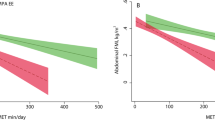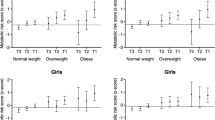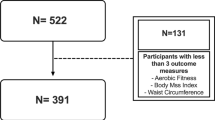Abstract
OBJECTIVES: To investigate the relationships between physical activity, dietary intake and body composition in children. DESIGN: A cross-sectional study on physical activity, nutritional intakes and body composition conducted in 86 healthy 10 y old French children. In addition, growth parameters and nutritional intakes were available from the age of 10 months. MEASUREMENTS: Physical activity level (using a validated activity questionnaire over the past year), nutritional intake (dietary history method), anthropometric measurements (body weight, height, arm circumference, triceps and subscapular skinfolds, Body Mass Index (BMI), arm muscle and arm fat areas calculated from these measurements) at the age of 10 y. Anthropometric measurements and nutritional intakes were recorded in the same children at the age of 10 months and every 2 y from the age of 2 y. RESULTS: At the age of 10 y, active children ingested significantly more energy than less active children, mostly due to higher energy intake at breakfast and in the afternoon. This higher energy intake was accounted for by increased consumption of carbohydrates (281 g vs 246 g; 49.6% vs 47.4% of total energy). Even if the amounts of fat consumed were similar in both groups (90 g vs 84 g; P=0.09), the percentage of fat intake was lower in active children (35.4% vs 37.4%; P=0.04). The percentage of protein was not different (14.9% vs 15.3%; P=0.33). In spite of a higher energy intake in the active group, active and less active children had similar BMI at the age of 10 y. However, their body composition differed significantly: active children had a higher proportion of fat-free mass, a lower proportion of fat-mass as measured in the arm and they had a later adiposity rebound. Fatness was significantly and positively associated with the time spent watching television and video games. CONCLUSIONS: Physical activity was associated with improved body composition and growth pattern. This association may be related to nutritional changes: active children consumed more energy by increasing carbohydrate, thus reducing the relative fat content of their diet. These results provide support to encourage physical activity during childhood.
This is a preview of subscription content, access via your institution
Access options
Subscribe to this journal
Receive 12 print issues and online access
$259.00 per year
only $21.58 per issue
Buy this article
- Purchase on Springer Link
- Instant access to full article PDF
Prices may be subject to local taxes which are calculated during checkout
Similar content being viewed by others
Author information
Authors and Affiliations
Rights and permissions
About this article
Cite this article
Deheeger, M., Rolland-Cachera, M. & Fontvieille, A. Physical activity and body composition in 10 year old French children: linkages with nutritional intake?. Int J Obes 21, 372–379 (1997). https://doi.org/10.1038/sj.ijo.0800415
Received:
Revised:
Accepted:
Issue Date:
DOI: https://doi.org/10.1038/sj.ijo.0800415
Keywords
This article is cited by
-
Age at adiposity rebound and the relevance for obesity: a systematic review and meta-analysis
International Journal of Obesity (2022)
-
The role and requirements of digestible dietary carbohydrates in infants and toddlers
European Journal of Clinical Nutrition (2012)
-
Geometric indices of hip bone strength in obese, overweight, and normal-weight adolescent boys
Osteoporosis International (2012)
-
Obesity and catecholamine responses to maximal exercise in adolescent girls
European Journal of Applied Physiology (2010)
-
Is food portion size a risk factor of childhood overweight?
European Journal of Clinical Nutrition (2009)



